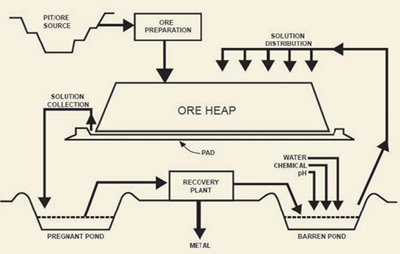
Schematic of typical heap leach process. Source: Van Zyle, D. J.A., et al. “Introduction to Evaluation,
Design and Operation of Precious Metal Heap Leaching Projects,” pp. 122-145, (1988).
Technical Factors for Selecting Optimum Heap Leach Pad Sites
Selection of a pad site can have significant, long-lasting effects on leaching
performance, safety and environmental impact
By Saeed Karimi Nasab, Azadeh Hojat and Mohammad Reza Mollaei Fard

Selection of a site for a heap leach pad may be undertaken using procedures used for tailings impoundment site selection. One of the early, but still relevant and applicable papers available on site selection is by Robertson et al.1 A similar but expanded approach is described in Caldwell and Robertson.2 In essence, the basic approach described in these two papers involves identifying candidate sites, comparing alternatives, communicating the subjective and objective criteria affecting the choice of site, and validating the site selected. Modern decision making theory as applied to site selection is described by Robertson and Shaw.3
Because conditions often vary significantly between sites—even those in close proximity—careful selection of the site having the most favorable set of advantages is a major design option. The selection process may involve many technical disciplines and can include both non-technical issues such as property availability, as well as technical criteria that include topography, geology, hydrology, environmental and engineering conditions.
Site selection involves evaluations of a number of factors, including distance from the mining area and dumped ore, environmental suitability, and the amount of earthwork that must be done to provide grading of the slope for proper drainage of the heap. Additional factors to be considered in site selection are: flood potential, subsoil conditions, and future prospecting potential for economic mineralization. Thorough testing of soil and rock beneath the proposed heap leach site is necessary to ensure stability of heaps.
Site Investigation Methodology
A desk study is usually conducted which
almost invariably involves the review of
topography, geological and vegetation
maps, as well as geological, climatological
and site investigation reports. This is
followed by site reconnaissance visits,
which can help to validate information
obtained during the desk study.
Fieldwork generally provides key technical
data such as:
• The sequence of soil and rock strata
with depth.
• Depth to bedrock.
• The distribution of soil and rock over
the study area.
• Discontinuity intensities of rock at the
site.
• Prediction of bedrock topography.
• Groundwater distribution and seasonal
variation.
• General direction of groundwater flow
and consequent contaminant threat of
leachate to groundwater resources.
• Aquifer properties.
Site Selection
Mining companies face the challenge of
effectively managing heap leaching facilities
through a life cycle, from site selection
to final closure. The first step in the
selection of sites for heap leach pads,
collection ponds, and the extraction
plant is the delineation of an area of
interest where sites can be defined and
selected. Because sites located far from
the mine may be uneconomic, a fixed
radius from the mine will typically define the area of interest. The length
of the
radius is a practical distance from the
mine dictated by hauling costs and other
operational factors. For heap leaching
facilities, the area of interest is within a
one-half to 1-mile radius.
Within the area of interest, there may be areas where facilities should not be sited for reasons that include ownership, topography, potential flood areas, subsoil conditions, and mineralization. The remaining sites are then screened to eliminate areas that are less suitable; i.e, steep topography, unfavorable geologic conditions, unacceptable hydrologic conditions such as high runoff (which can not be diverted easily), risk of failure, environmental considerations, etc. The remaining candidates are then compared to determine the best (or sometimes the least unacceptable) site.
The site selection process is generally an extension of good judgement and common sense. For some projects, only one site may be available or one may be substantially better than all others, and the process is not required. For other projects, several good sites may be available but the optimum site among them is not readily apparent. In such a case, the site selection process is used to determine which site would be preferable. Costs involved in the site selection process may be offset by future engineering, construction or operational cost savings.
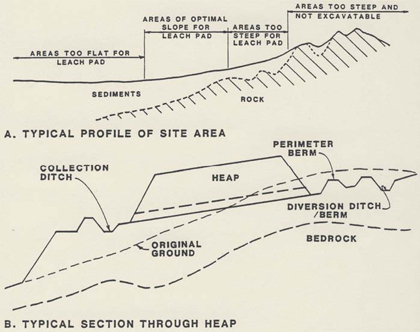
The slope of the pad and associated liners is very often controlled by the existing topography. The slope of the pad must be steep enough to allow efficient drainage of the leachate but not so steep that the stability of the heap is jeopardized or that erosion of the liner occurs. In many cases, it is possible to construct a leach pad using the existing topography without significant cut and fill.
Meteorological Conditions
Characterization of the meteorological
conditions of a heap leach site includes
collecting historic data about site precipitation,
evaporation, snow, humidity, temperatures,
and wind. Interaction of climate
and the design and performance of
mine waste management facilities is
described by Hutchinson and Ellison.4
Specifically with regard to heap leach
pads, they consider the following climatic
factors and their significance:
• Short-term–intense rainfall affects the
size of ponds, ditches, and containment
dikes that need to be designed to
avoid erosion and/or overtopping.
• Long-term–weather patterns affect the
overall water-balance performance of
the pad as regards infiltration, evaporation,
and hence the quantity of flow
from the pad.
It is also necessary to evaluate wind direction and velocity in the potential sites. Wind direction and velocity are critical because of dust problems that can be caused by erosion, especially in sites up-gradient from towns, recreation areas, farm lands, etc. Persistent high-velocity winds can also complicate reclamation of abandoned heaps. An example of the use of climatic data in the design and performance evaluation of heap leach pads and similar mine waste disposal facilities is provided in Wels et al.5
Hydrology
Hydrologic studies consist primarily of
the acquisition of data on precipitation
and runoff. Runoff estimates indicate
the rate at which non-process water can
be expected to enter the site. Diversion
systems (ditches, berms, etc.) should be
designed to handle extraneous water.
Precipitation can affect leaching operation
in several ways. It reduces pH and
density of the solutions. Collection
ponds should be designed larger to store
leaching solutions as well as rainwater
collected from the heap and channels.
The pregnant solution pond must be
designed to receive runoff from a 100-
year maximum flood occurring in the
total heap area being drained. This pond
must handle runoff from the annual
spring snowmelt. Sometimes, it is necessary
to cover the heap surface with
impermeable materials to prevent rainwater
from percolating through the heap.
Geology
The geology of a heap leach pad should
be established comprehensively. This
may be done during geological studies
usually undertaken as part of the overall
mine investigation, characterization, and
development. Geological data about the
origin, location, and engineering characteristic
of site and local soils, rocks, and
groundwater should be obtained.6
Hydrogeology
The interaction of site groundwater and a heap leach pad is discussed
by Hutchinson and Ellison.4 In theory there is no interaction
of the heap leach pad and groundwater because the liner
placed at the base of the pad precludes passage of groundwater
up into the heap and passage of seepage from the heap to
groundwater. In practice, the following considerations give rise
to a need to integrate heap leach pad design and operation with
groundwater evaluations:
• Springs and/or artesian groundwater flow at the heap leach pad
site may necessitate placement of drains beneath the liner,
• Holes in the liner may result in the passage of leachate to the
groundwater,
• Water pressure beneath the pad may affect slope stability.
Therefore, the site selection process for the proposed facility
should include consideration of subsurface hydrogeological
conditions within and adjacent to the potential zone of influence
of the proposed site. A risk assessment of potential
impacts on groundwater chemistry, levels and appropriate
groundwater pressure should be conducted as a minimum. It is
essential to determine groundwater flow system in the vicinity
of the site from which escaping solutions may be released to
underground aquifers. The most appropriate rules for site selection
according to hydrogeological characteristics are:
• Select the site underlain by the maximum possible thickness
of unsaturated materials.
• Select the site underlain by materials with lowest possible
permeability.
• Select the site not underlain by shallow aquifers without confining
layers.
• Avoid sites that are adjacent to streams where groundwater
and the contaminated seepage it collects will discharge
immediately to the stream.
• Provide seepage collection facilities where seepage is
anticipated.
• No heap leach facility shall be constructed on reclaimed or
filled land.
Geotechnical Studies
The general geologic and geotechnical characteristics of potential
areas should be among the first factors to be examined.
Depth to and topography of buried bedrock should be determined
for structural and drainage purposes. Unconsolidated
materials should be mapped and their grain-size distribution,
permeability, and engineering properties determined so
that potential settlement, leakage, and other failure problems
can be anticipated and incorporated into the design of facilities.
In general, a geotechnical site investigation for a heap leaching
project is conducted to gather the following information:
• Foundation conditions beneath the heap, ponds, and other
areas where additional load is added to change the stress conditions
in existing rock and subsoil.
• Excavation conditions, or how easily materials can be excavated
in areas where cuts are required.
• Quality and quantity of potential construction materials available
for liners, drainage material, and structural fill.
• Hazards associated with the site such as recent or active
faulting, unacceptable groundwater conditions, or soft or
collapsible soils.
• General identification of geologic and
hydrogeologic conditions beneath
structures such as the heap pad and
collection ponds.
Techniques used to gather this information vary from surface reconnaissance to backhoe trenching and drilling.
One important consideration associated with such facilities is differential settlement. Settlement of the underlying foundation may lead to disruption of the leach pad system. Differential settlement typically results from one of three causes: the liner spans soils of differing compressibility, the slope and height of the heap are extreme or local settlement results from leaks in the liner. The later cause can be significant where the soils contain high concentrations of acid soluble salt.7
The geotechnical risk assessment may also include a seismic assessment of the site as well as an assessment of the liquefaction potential of foundation, construction and stored materials. The investigation(s) should provide a high level of confidence in the physicochemical characteristics, the engineering and hydrogeological properties, and the behavior of the foundation, construction and stored materials under normal operating and seismic loading conditions.
Leach pads—particular those involved in copper ore leaching—can be enormous, reaching areas in excess of 5 million m2. This often precludes selecting of the optimum site from a geotechnical standpoint. It also requires a liner system to span a wide range of geologic profiles.
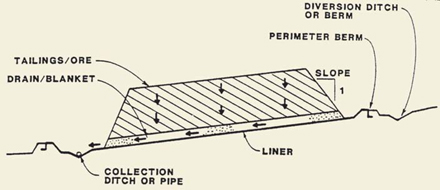
Exploratory procedures for construction materials involve pitting, trenching, and drilling. The exploration program should identify alternative sites as to quantities of the various classes of construction materials available. The materials at the alternative sites should be classed according to volume available, water content, grain-size distribution, compaction characteristics and shear strengths.
The characteristics of natural materials vary from site to site, and even within parts of a particular area. Because of the variability of these materials, and their potential use as an important component of the leach facility, their geotechnical characteristics (as well as their quantity) should be determined.
Environmental Considerations
Although heap leaching facilities have
leak detection systems and often use
double liners, most facilities employ
leak detection or monitoring systems so
that leaks can be discovered and remediated.
However, there is always the
possibility that detection will fail and
leakage will escape to the underlying
strata.
In general, heap leach facilities can
cause the following major types of environmental
impacts:
• Solution containing ponds and ditches
can present an acute hazard to wildlife
and birds.
• Spills of leaching solutions can enter
surface water and contaminate drinking
water sources; or they can enter
groundwater systems and contaminate
water supply wells.
• Chemical solutions in the active heaps
and solution ponds may reach water
sources through leaks from leach pads
and liners.
• Catastrophic failure of heap leach pads
can release chemicals into streams and
groundwater.
Such problems associated with chemical solutions in heaps have led operators to explore preventive strategies. These include reviewing environmental parameters in the initial site selection. The proper location of heap leaching facilities can be the most simple and the most effective factor in enhancing the successful long-term protection of groundwater quality. Proper site selection also represents the most powerful tool available to the engineers in ensuring the long-term stability of a heap leach pad.
Preparing an environmental assessment requires a number of environmental studies in the region of the proposed site. These studies generally address geology, hydrology, soils, vegetation, wildlife, aquatic features, history and archaeological aspects of the area.
Heap leaching ponds may also attract animals and birds for water. Consequently, preventing bird poisoning on wet heaps and ponds, especially in desert climates where the ponds are attractive sources of water, is a concern.
However, the major environmental concern with heap leaching is contamination of surface and ground waters with chemicals in the leaching solutions. The closure of heaps which have ceased to be productive requires taking account of additional environmental considerations
Mineralization
Leached ore is typically left in place,
which means that a site should be located
where no economic mineralization lies
under the permanent disposal of the
leached ore residue. Some exploration
drilling may be appropriate to ensure that
the selected site does not overlay economic
mineralization.
Distance from Mining Area
Leach pad foundations are designed for
high stability to prevent movement or
cracking of the pad liner under the
weight of the ore heaps, which may reach
heights of 60 to 70 m or more. However,
heap movement may occur with high
heaps or heaps located on steeply sloping
sites. This problem should be considered
in the site selection process in order to
select sites safely removed from the mining
area.
Conclusions
Experience across the mining industry
has consistently demonstrated that the
most significant catastrophic risk posed
by mining operations on the environment
arises from the construction and
operation of tailings, heap leach pads
and water storage facilities. Because of
the long-term nature of the pollution
and environmental impact of many such
facilities, the selected site must serve
as an effective area, not only in the
short term, but also in the very long
term. The proper location of heap leaching
facilities can be the most simple
and the most effective factor in enhancing
successful long-term efficiency of
the facility.
The authors wish to thank National Iranian Copper Industries Co. for supporting this research.
References
1. Robertson, A. et al. “Uranium Mill
Tailings Impoundment Site Selection,”
Symposium on Uranium Mill
Tailings Management, Fort Collins,
Colorado, (1980).
2. Caldwell, J.A., and Robertson, A.,
“Selection of Tailings Impoundment
Sites,” The Civil Engineer in South
Africa, (1983).
3. Caldwell, J. “Technology Review;
Heap Leach Pads,” Infomine, (2006).
4. Hutchinson, I. P.G., and Ellison, R.
D., “Mine Waste Management,” Lewis
Publishers, pp. 453- 497, (1992).
5. Wels, C., et al. “Infiltration Test Plot
study for Mine Rock Piles at Questa
Mine, New Mexico.” 2001 National
Meeting of the American Society for
surface Mining and Reclamation,
Albuquerque, NM, (2001).
6. Miguas, R.E. “Geology and Engineering
Geology in the Siting of Complex
Public Facilities,” Geotechnical Site
Characterization, (1998).
7. http://www.geomembrane.com/PGI
Saeed Karimi Nasab is assistant professor,
Mining Engineering Department,
Shahid Bahonar University of Kerman, Email:
kariminasab@mail.uk.ac.ir. Azadeh
Hojat is a Ph.D. student of geophysics,
Institute of Geophysics, University of
Tehran, Tehran, Iran, E-mail:
ahojat@ut.ac.ir. Mohammad Reza Mollaei
Fard is a mining engineer, National
Iranian Copper Industries Co. E-mail:
mollaeifard@nicico.org.
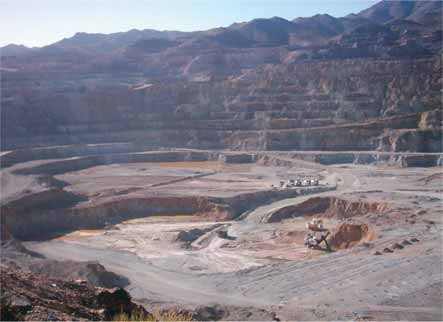 The Sarcheshmeh copper mine is located 160 km south west of Kerman and 50 km south of Rafsanjan in Iran. Its copper deposits are situated in the central Zagros mountain range, principally composed of a folded and faulted early tertiary volcano- sedimentary complex. The copper complex includes the mine, concentrator, smelter, refinery, casting and leaching units. Heap Leaching at Sarcheshmeh Heap leaching has been used to extract copper from oxide ore at the Sarcheshmeh copper mine in southern Iran since the 1990s. The total amount of oxide ore available at the mine is approximately 28 million mt. Sarcheshmeh is the only mine in Iran utilizing heap leaching technology. After technical studies of various leaching methods revealed that heap leaching was the only viable method to extract copper from oxide ore at Sarcheshmeh, the National Iranian Copper Industries Co. (NICICO) decided to construct two heaps in the northeastern and northwestern sides of the mine, respectively. Heap No. 2 was commissioned in 2001 after Heap No. 1 had been in service for several years. Heap No. 1 is now in its last year of operation. Of all the alternative sites evaluated by NICICO, the two locations finally selected had the following characteristics: • Topography of the selected sites was most favorable of all sites considered in the eastern and western parts of the mine. However, Heap No. 2 is located on a steep slope that required more earthworks construction and its associated higher costs to provide an acceptable leach pad slope. Heap No.1 is on a much flatter slope. • The required storage area available at the two selected sites exceeds that of the other sites. The second heap leaching area extends over 300,000 m2 in a steep valley situated at the western side of the mine. 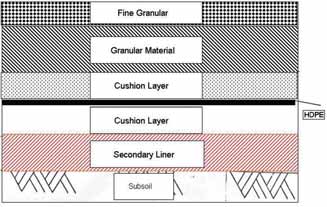 Schematic illustration of base liners used at Sarcheshmeh’s leach pads. Source: Karimi Nasab S., M. R. Mollaei Fard, et al., 2003, “Stability Analysis of the Second Site of the Sarcheshmeh Heap Leaching,” 18th Mining Congress of Turkey. • Site selection of both heaps satisfied the requirements for reason able distance to the dumped ore from an ore haulage economics standpoint. • Both heaps offer safe hydrogeological conditions. • Heap No. 2 is near the mine, while Heap No. 1 is located far from the mining operation area. • A double-layer liner system was used in the construction of both heaps, minimizing the possibility of seepage of chemical solutions. • No vegetation or wildlife exist near the heap sites. • According to the information available, neither of the two selected sites sat atop economic mineralization. • Because the copper complex already owned the land on which both sites were located, permitting was not a problem. Results of maximum acceleration measurements show relative stability of heap leach pads and the behavior of the foundation, construction and stored materials under normal mine blasting conditions. However, Heap No. 2 will be closer to the mining area as the mine expands. As a result, careful studies are necessary to evaluate long-term stability of the heap site and modify blasting patterns if necessary. |